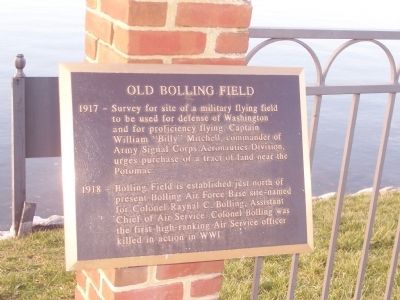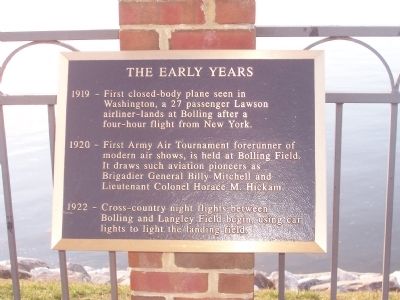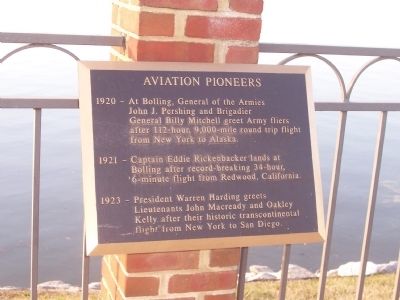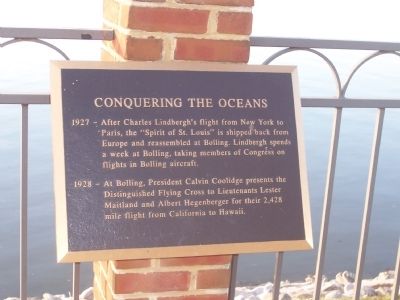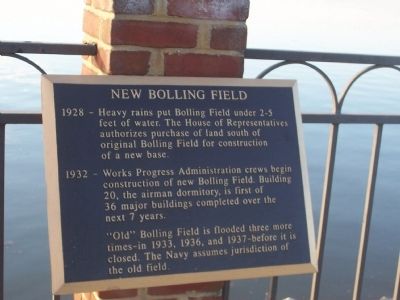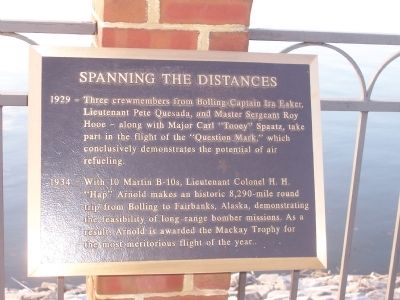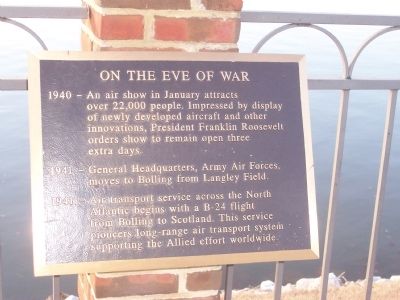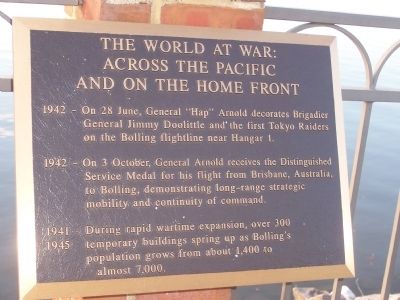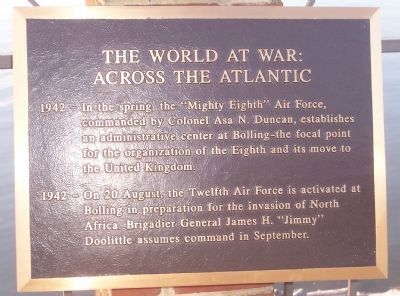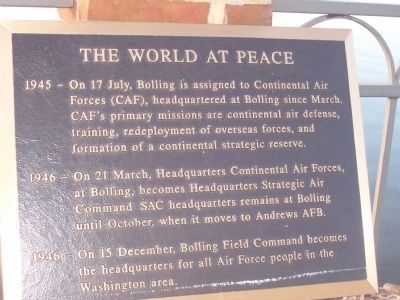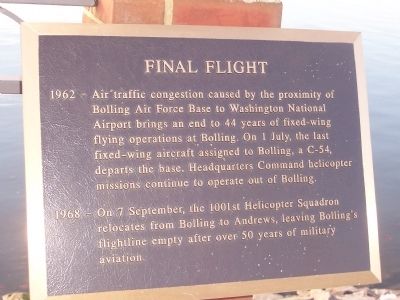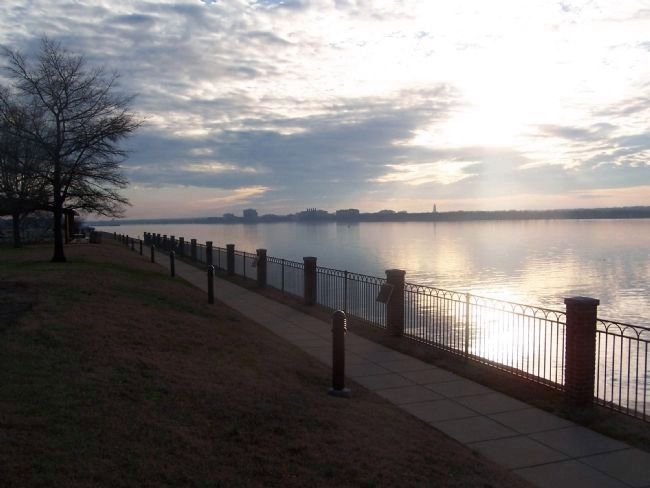Joint Base Anacostia-Bolling (JBAB) in Southwest Washington in Washington, District of Columbia — The American Northeast (Mid-Atlantic)
Bolling Air Force Base
Old Bolling Field
1917 - Survey for the site of a military flying field to be used for defense of Washington and for proficiency flying. Captain William "Billy" Mitchell, commander of Army Signal Corps Aeronautics Division urges purchase of a tract of land near the Potomac.
1918 - Bolling Field is established just north of the present Bolling Air Force Base site - named for Colonel Raynal C. Bolling, Assistant Chief of Air Service. Colonel Bolling was the first high-ranking Air Service officer killed in action in WWI.
[Panel 2]:
The Early Years
1919 - First closed-body plane seen in Washington, a 27-passenger Lawson airliner, lands at Bolling after a four-hour flight from New York.
1920 - First Army Tournament, forerunner of modern air shows, is held at Bolling Field. It draws such aviation pioneers as Brigadier General Billy Mitchell and Lieutenant Colonel Horace M. Hickam.
1922 - Cross-country night flights between Bolling and Langley Field begin, using car lights to light the landing field.
[Panel 3]:
Aviation Pioneers
1920 - At Bolling, General of the Armies John J. Pershing and Brigadier General Billy Mitchell greet Army fliers after 112-hour, 9,000-mile round trip flight from New York to Alaska.
1921 - Captain Eddie Rickenbacker lands at Bolling after record-breaking 34-hour, 6-minute flight from Redwood, California.
1923 - President Warren Harding greets Lieutenants John Macready and Oakley Kelly after their historic transcontinental flight from New York to San Diego.
[Panel 4]:
Conquering the Oceans
1927 - After Charles Lindbergh's flight from New York to Paris, the "Spirit of St. Louis" is shipped back from Europe and reassembled at Bolling. Lindbergh spends a week at Bolling, taking members of Congress on flights in Bolling aircraft.
1928 - At Bolling, President Calvin Coolidge presents the distinguished Flying Cross to Lieutenants Lester Maitland and Albert Hegenberger for their 2,428-mile flight from California to Hawaii.
[Panel 5]:
New Bolling Field
1928 - Heavy rains put Bolling Field under 2-5 feet of water. The House of Representatives authorizes purchase of land south of original Bolling Field for construction of a new base.
1932 - Works Progress Administration crews begin construction of new Bolling Field. Building 20, the airman dormitory, is first of 36 major buildings completed over the next 7 years.
[Panel 6]:
Spanning the Distances
1929 - Three crewmembers from Bolling: Captain Ira Eaker, Lieutenant Pete Quesada, and Master Sergeant Roy Hooe - along with Major Carl "Tooey" Spaatz, take part in the flight of the "Question Mark," which conclusively demonstrates the potential of air refueling.
1934 - With 10 Martin B-10s, Lieutenant Colonel H. H. "Hap" Arnold makes an historic 8,290-mile round trip from Bolling to Fairbanks, Alaska, demonstrating the feasibility of long-range bombing missions. As a result, Arnold is awarded the Mackay Trophy for the most meritorious flight of the year.
[Panel 7]:
On the Eve of War
1940 - An air show in January attracts over 22,000 people. Impressed by display of newly developed aircraft and other innovations, President Franklin Roosevelt orders show to remain open three extra days.
1941 - General Headquarters, Army Air Forces moves to Bolling from Langley Field.
1941 - Air transport service across the North Atlantic begins with a B-24 flight from Bolling to Scotland. This service pioneers long-range air transport system supporting the Allied effort worldwide.
[Panel 8]:
The World at War: Across the Pacific and on the Home Front
1942 - On 28 June, General "Hap" Arnold decorates Brigadier General Jimmy Doolittle and the first Tokyo Raiders on the Bolling flightline near Hanger 1.
1942 - On 3 October, General Arnold receives the Distinguished Service Medal for his flight from Brisbane, Australia to Bolling, demonstrating long-range strategic mobility and continuity of command.
1941-1945 - During rapid wartime expansion, over 300 temporary buildings spring up as Bolling's population grows from about 1,400 to almost 7,000.
[Panel 9]:
The World at War: Across the Atlantic
1942 - In the spring, the "Mighty Eighth" Air Force, commanded by Colonel Asa N. Duncan, establishes an administrative center at Bolling - the focal point for the organization of the Eighth and its move to the United Kingdom.
1942 - On 20 August, the Twelfth Air Force is activated at Bolling in preparation for the invasion of North Africa. Brigadier General James H. "Jimmy" Doolittle assumes command in September.
[Panel 10]:
The World at Peace
1945 - On 17 July, Bolling is assigned to Continental Air Forces (CAF), headquartered at Bolling since March. CAF's primary missions are continental air defense, training, redeployment of overseas forces, and formation of a continental strategic reserve.
1946 - On 21 March, Headquarters Continental Air Forces, at Bolling becomes Headquarters Strategic Air Command. SAC headquarters remains at Bolling until October, when it moves to Andrews AFB.
1946 - On 15 December, Bolling Field Command becomes headquarters for all Air Force people in the Washington area.
[Panel 11]:
Final Flight
1962 - Air traffic congestion caused by the proximity of Bolling Air Force Base to Washington National Airport brings an end to 44 years of fixed-wing flying operations at Bolling. On 1 July, the last fixed-wing aircraft assigned to Bolling, a C-54, departs the base. Headquarters Command helicopter missions continue to operate out of Bolling.
1968 - On 7 September, the 1001st Helicopter Squadron relocates from Bolling to Andrews, leaving Bolling's flightline empty after 50 years of military aviation.
Erected by U.S. Air Force.
Topics and series. This historical marker is listed in these topic lists: Air & Space • Notable Places • War, World I • War, World II. In addition, it is included in the Distinguished Service Medal, the Former U.S. Presidents: #29 Warren G. Harding, the Former U.S. Presidents: #30 Calvin Coolidge, the Valor in Aerial Operations, and the Works Progress Administration (WPA) projects series lists. A significant historical year for this entry is 1917.
Location. 38° 50.509′ N, 77° 1.352′ W. Marker is in Southwest Washington in Washington, District of Columbia. It is in Joint Base Anacostia-Bolling (JBAB). Marker can be reached from Arnold Avenue Southwest, 0.1 miles north of Tinker Street Southwest, on the left when traveling north. The markers are along the western perimeter of Bolling Air Force Base, adjacent to the picnic area and riverfront pedestrian trail in the Bolling Green Park recreation area. Touch for map. Marker is at or near this postal address: 5474 Arnold Avenue Southwest, Washington DC 20032, United States of America. Touch for directions.
Other nearby markers. At least 8 other markers are within 2 miles of this marker, measured as the crow flies. In Memory of Col. Raynal C. Bolling (approx. 0.6 miles away); Republic F-105D Thunderchief (approx. 0.6 miles away); Fort Carroll (approx. 0.9 miles away); Ronald Reagan (approx. 1.2 miles away in Virginia); Fort Greble (approx. 1.2 miles away); "The Gun" (approx. 1.2 miles away); Engineering a Landmark (approx. 1.2 miles away); Congress Heights School (approx. 1.3 miles away). Touch for a list and map of all markers in Southwest Washington.
More about this marker. Visitors without military identification are currently required to enter the base via the south entrance off South Capitol Street. After obtaining a visitor's pass, proceed northwest along Chappie James Blvd. to Tinker Street (1st signal light) and turn left. Arnold Avenue is at the next intersection. Turn right, and the Bolling Green parking area will be immediately on the left.
Additional keywords. Joint Base Anacostia-Bolling (JBAB)
Credits. This page was last revised on January 30, 2023. It was originally submitted on June 27, 2008, by Richard E. Miller of Oxon Hill, Maryland. This page has been viewed 4,063 times since then and 103 times this year. Last updated on March 24, 2013, by Richard E. Miller of Oxon Hill, Maryland. Photos: 1, 2, 3, 4, 5, 6, 7, 8, 9, 10, 11, 12. submitted on June 27, 2008, by Richard E. Miller of Oxon Hill, Maryland. • Bill Pfingsten was the editor who published this page.
